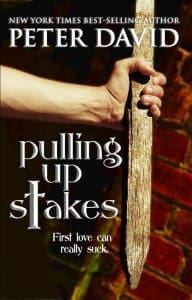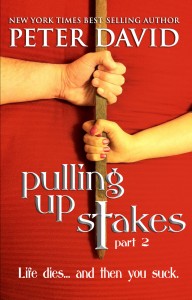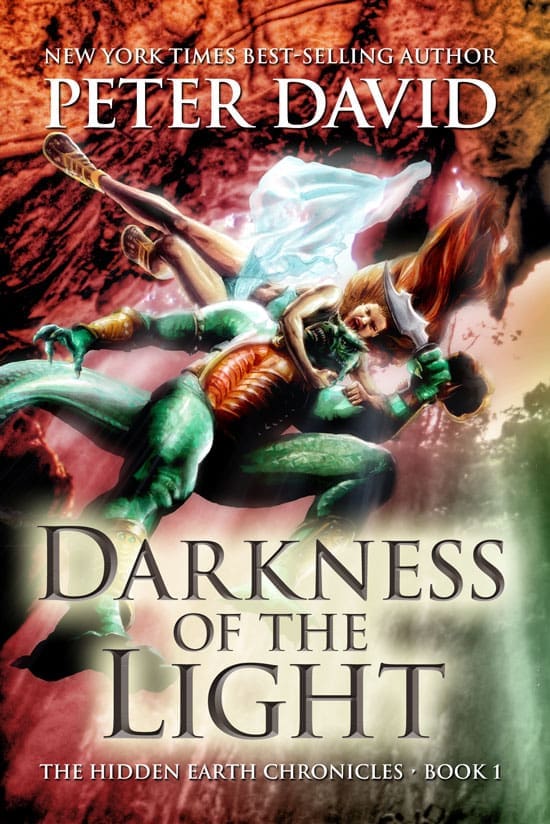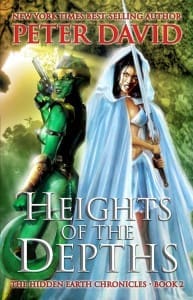 Originally published January 10, 1997, in Comics Buyer’s Guide #1208
Originally published January 10, 1997, in Comics Buyer’s Guide #1208
When I was a kid, there were cards that my parents wouldn’t let me get because my father, in particular, had a real thing about not wanting ghastly or hideous images in the house. And cards where demented big-brained, skull-faced creatures are incinerating everything in sight certainly qualified. Essentially I wound up collecting Batman cards, instead, but I would always look on in envy at kids in the schoolyard, surreptitiously flipping through that subversive celebration of the grotesque called Mars Attacks.
But now we’re into the 1990s, and it’s difficult to find anything so subversive that it cannot somehow be made into something appropriate for all ages. (I mean, hëll, if they could make an animated series out of Highlander, they can pretty much do anything.)
There was some concern months back that Mars Attacks, the film, was pretty much going to have its thunder stolen by Independence Day. Wouldn’t the movie-going public think that anything having to do with alien invasion would have a feeling of “been there, done that” after the pile-it-on excess of ID4?
Not really. Because, although both films are nominally about alien invasion, their origins could not have been more dissimilar. ID4 has its roots (from visual style to characterization to plot development) in every other science fiction film from the past 30 years. That’s why ID4 has such a comfortably familiar feel to it.
Mars Attacks, on the other hand, comes from the cards set. Whereas ID4 is based on old stories, Mars Attacks comes from old images. This makes it ideal for visual stylist Tim Burton, since telling a coherent (or even interesting) story has never been Burton’s forte. Burton’s pictures have always been far more about style than substance, chockablock with characters who are flat and cartoony and never aspire to be anything more than that.
This basically means that Mars Attacks‘ greatest strength is also its greatest weakness. All the visuals are there, but the moment the story wanders away from the visuals, then there is no story aside from destruction.
This isn’t to say that destruction isn’t carried off in spectacular fashion. ID4 focused mostly on obliteration of real estate. Sure, people died too—by the carload—but it was all as a result of ships from overhead, piloted by mostly unseen aliens (until later in the film), blasting away with super-powerful death rays. It had an almost impersonal feel about it.
But the Martians are a different story altogether. The Martians are up close and personal. They blast away at close range with ray guns, gleefully incinerating 99% of their victims and performing bizarre experiments on the rest. Actually, “bizarre” may be an understatement. A scene involving a budding romance between a dippy talk show host (Sarah Jessica Parker) and a stuffy, pipe-smoking scientist (Pierce Brosnan), neither of them with a head in the generally accepted location, has got to be the most surreal sequence I’ve ever seen in a Tim Burton film. Possible in any film.
Annoyed that the ID4 aliens claiming that they wanted our resources was unbelievable? Worry not. No discernable reason is ever given for the Martians coming after Earth, and, in a way, that’s almost easier to buy. If we had to make any guesses as to motivation, it would seem to be for the same reason that George Leigh Mallory gave when asked why he wanted to scale Mount Everest: “Because it is there.”
If anything, they seem to be destroying everything in sight just for kicks. They chortle with demented glee over their atrocities. They pose, like extraterrestrial tourists, in front of mighty landmarks before incinerating them. They mow down city blocks while declaring, “Do not run. We are your friends”—certainly the most disconcerting public warning since Soviet soldiers wandered a small New England town calling, “Emerchency. Effrybody to get from street,” in The Russians Are Coming, the Russians Are Coming!
The Martians giggle, they frolic, they are joyously sure of themselves, they rearrange Mt. Rushmore, they sing backup for Tom Jones (don’t ask). They attack because, well, Mars attacks. It says so right in the title of the film. If they did anything else, Warner Bros. could be accused of false advertising.
The film carries with it the mentality of an Irwin Allen disaster film—you know, one of those movies where there are all kinds of big stars, most of whom die in spectacular fashion. One of the perverse allures in seeing such a film is wondering who’s going to survive. I assure you that, no matter how cynical and seen-it-all you are, sooner or later there will come some point in the movie when you’ll say, “Wow! I didn’t think (fill in the blank) was gonna buy it.”
The problems inherent in this film are the same problems, unfortunately, inherent in almost everything Tim Burton directs. The story doesn’t so much flow as it just kind of happens. Indeed, Jonathan Gems’ script seems to suffer from pieces missing, either in terms of exposition or in plot threads not followed through. The film’s opening sequence involves a stampeding herd of cattle, running while ablaze. The ostensible reason is that the Martians want to rid the world of its beef supply. But the explanation is never given in the film. And why would they want to do this when they’re just planning to incinerate humanity, anyway? Who knows? The aliens have an aversion to birds. That’s shown early on and is a recurring scenario. The audience figures that it’s going to tie into the end somehow. But there’s never any payoff. Why do birds upset them? Again, who knows? Perhaps Gems knows, but he didn’t say. Perhaps Burton knows, but he didn’t care.
As a result, we don’t care all that much either. With the sole exception of Jim Brown’s behemoth of a former boxer, none of the characters are particularly engaging or involving. (Although Jack Nicholson and Glenn Close as the clueless president and his somewhat more savvy first lady are standouts). When someone is incinerated, we don’t find ourselves saying, “Oh no! That character is dead?” Instead, we say, “So much for (fill in the star’s name).” The characters are there merely to bridge time between the set pieces of Martians creating havoc.
Is it worth seeing? Yeah. I guess. It’s fun to watch big-name actors run around like headless chickens (almost literally in some instances). The computer-animated Martians are a hoot. Watching Tim Burton’s main squeeze, Lisa Marie, glide through the movie as a Martian spy (complete with beehive hairdo to hide her gigantic brain) is alone nearly worth the price of admission. And the manner in which the Martians are beaten, well—at least it’s not a virus. It’s a bit like the climax of Close Encounters, if that film had involved hostile aliens and the writers had dropped some serious acid just before beginning it.
What I find interesting, though, is that how we perceive aliens has reflected the changes in America.
Think about it. The 1950s brought audiences Invasion of the Body Snatchers (1956) and It Came from Outer Space (1953), which aliens were evil and invasive. Sometimes (as in Body Snatchers) critics saw them as a metaphor for Communists who looked just like us but were insidiously trying to take our country away from us. The only aliens who were at all friendly were Superman and, in Visit to a Small Planet, Jerry Lewis.
But the 1960s provided a time of self-examination, of change. Not coincidentally, one of the foremost friendly aliens first showed up around that time on TV (with pointy ears and slanted eyebrows, which scared the bejesus out of the networks, who worried that religious Americans would be offended by the weekly appearances of a Satanic individual). But Gene Roddenberry managed to steamroll his concept through, and Mr. Spock—a future icon, not to mention icon of the future—paved the way for friendly alien-Terran relations. Long before “Can’t we all just get along?” entered common parlance, the starship Enterprise answered that question with a resounding “Yes.”
Other friendly aliens followed. Spock (1966) made aliens cool. Close Encounters of the Third Kind (1977) made them symphonic. E.T. (1982) made them solemn, wise, lovable, and—what was most important—plush and, therefore, highly marketable. Starman (1984) kind of combined all of that and gave us a priceless view of alien terrestrial driving technique (“You said you watched me drive! You said you knew the rules!” “I do know the rules. I watched very carefully. Red, stop. Green, go. Yellow, go very fast.”) Star Wars (1977) was crawling with them in all sizes and shapes, both good and bad, although you could for the most part tell the good guys because they were short (Yoda), furry (Wookiees), or short and furry (Ewoks).
But an air of greed had permeated the atmosphere. “Greed is good,” intoned Gordon Gekko in Wall Street (1987). Those who had were more intent than ever on keeping what they had, and the message to anyone who was trying to take it away was “hands off.” The outsider was not welcome: that “alien” represented from abroad by foreign interests or from within society by the poor, needy, and welfare-dependent or even from within ourselves by AIDS, the diseased that transformed love into death. That which had been mere silliness in the 1960s became the watchword of the 1980s and, for that matter, the 1990s. And that watchword was “Watch your back.”
As a result, aliens in the movies began to change. The tail end of the ’70s saw, appropriately, a remake of Invasion of the Body Snatchers (1978), ushering in a time when enemies, unseen and frightening, walked among us once more. Blade Runner (1982), based on Philip K. Ðìçk’s 1968 work Do Androids Dream of Electric Sheep?, gave us, not aliens, but androids so humanoid that they could walk among us. Fun robots such as C-3PO had been replaced by replicants, the inhuman menace we had brought among ourselves. An extraterrestrial as represented by E.T. gave way to the monstrous Alien in the 1979 Ridley Scott film and to the horde of Aliens and Predator(s) that followed.
“I’ll be riiiight here,” murmured in a gravelly-yet-childlike voice, was replaced by Roddy Piper in They Live (1988) declaring war on unseen invaders by saying, “I’m here to kick ášš and chew gum, and I’m all out of gum,” or Will Smith announcing, “Just looking forward to kicking E.T.’s butt, sir.” To say nothing of The X-Files, where aliens are involved in some dark, frightening conspiracy that could very well reach into the innermost regions of the government.
Only Star Trek remained tough to categorize. Just as TOS ushered in the friendly aliens in the 1960s, Star Trek: The Next Generation maintained the benevolent United Federation of Planets as a backdrop of alien cooperation. Indeed, the series and characters therein became even more peaceful, as even the once hostile Klingons became allies and the crew members never argued among themselves—which occasionally made Trek seem stodgy and dull in comparison to what else was out there. Where once Star Trek was mainstream dramatic science fiction, somewhere along the way it morphed into an entity unto itself. Star Trek was judged, not against other dramatic science fiction, but against other Star Trek and so took itself out of the running in terms of shaping science fiction viewing habits.
So where does that leave us? ID4 and Mars Attacks take joy—almost demented joy—in depicting alien foreign relations as a firestorm of violence. Perhaps as Americans become more insular, more cocky, more sure that we’ve learned everything we need to know, the thought of encountering alien life forms is no longer regarded as a potential learning experience. It’s no longer “What can we learn from them?” It’s “What do they want from us?”
Ironic, really. Two phrases of three words each embody what’s happened to dramatic science fiction in the past 20 years.
Think about it: We’ve gone from “Trust the Force” to “Trust no one.”
(Peter David, writer of stuff, can be written to at Second Age, Inc., P.O. Box 239, Bayport, NY 11705.)





The ending of “Mars Attacks” owes a lot to “Attack of the Killer Tomatoes”, of all things.
Without delving into the rest of the stuff (“Don’t give me that Star Trek crap, it’s too early in the mornin’!”), I just want to say that, I enjoyed the hëll out of Mars Attacks! But I enjoyed Independence Day at the time, too.
ID4 certainly gets played a lot more often on TV these days than Mars Attacks!, but I think the latter is the one that holds up better.
I think the over the top nature of the situation just works better in Mars Attacks! because it’s never really taking itself too seriously. I don’t find the whole “We want your resources” to be a real problem with ID4, but the defeat of the aliens certainly was.
With Mars Attacks!, I like the fact that no reason is given; sometimes, there just isn’t a motive. But the way the aliens are defeated? Well, I don’t know if it makes more sense than ID4, but it doesn’t require nearly the stretch in believability.
Perhaps not surprisingly, according to IMDb’s trivia for the film the trading cards were not only the inspiration for the film, but also used by Burton directly to pitch the film to WB.
This is probably the only Burton film I hate (but Dark Shadows really looks like a film to be joining that short list.)
Haven’t seen them all, but, YEAH. A colossal waste of time and a bore.
I don’t hate it. It’s one of two or three Burton movies I don’t own, and I don’t know that I ever will.
“sooner or later there will come some point in the movie when you’ll say, “Wow! I didn’t think (fill in the blank) was gonna buy it.””
For me that was Micheal J. Fox. He was at or near the height of his movie career and I was sure he’d be the big hero.
I guess you’re right about the stars being more important than the characters they played. Maybe that’s why I was rooting for Tom Jones more than anyone else. They just called him Tom Jones and I accepted it as both character and actor.
I LOVE Mars Attacks! I think it’s some kind of absurdist masterpiece. It’s hysterically droll and just ridiculously fun. Your review seems to forget that it’s a comedy — analyzing the plot makes as much sense as analyzing the plot of a Mel Brooks movie. And I can’t believe you didn’t find any of the characters engaging or interesting. If nothing else, Lukas Haas (the real star of the movie) and his grandmother were adorable.
The way the aliens aped expectations without making sense of them to us struck me as appropriately alien. The history of intercultural invasion gets awfully weird.
One of my best movie experiences happened because of “Mars Attacks”… they did a sneak preview of the film a few weeks before it actually opened, and the sneak was the same weekend as a science fiction convention here in Knoxville – so the theater was packed wall to wall with people from the con…
Part of the deal with the sneak was you got to stay and see “Space Jam” for free – what the hëll, free movie, right? So most of us stayed… and since this was Thanksgiving weekend, this was also the first time the theater switched from their Musak to running Christmas carols under all the slides they ran during the shows…
So – theater full of convention people, we’ve all just seen “Mars Attacks”, we’re waiting to heckle a sub-par movie, and they start playing “Jingle Bells”… someone in the audience decided to sing along…
…in Martian.
Within seconds, you had close to 400 people (many in costume!) all singing along, *all* in Martian…
It was wonderful… although I’m still curious what the theater staff thought of us… 🙂
Like many “Mars Attacks” card set aficionados, I’ve mentally purged Burton’s wrong-headed film adaptation from my brain. In short, like George Pal’s 1975 Doc Savage film adaptation, Dino De Laurentiis’ 1976 King Kong film adaptation, or De Laurentiis’ 1980 Flash Gordon adaptation, I simply pretend Burton’s film never happened. Sometimes, those adapting films from other popular culture source material just don’t get what it was that made the original intriguing, a cult favorite, or popular in the first place. In addition, film audiences can sense when the original source material is not respected, and they usually respond accordingly. Me? Well I’m looking forward to the Topps 50th anniversary heritage reissue of the original card set later this year — a reissue which I have the privilege of doing some of the special sketch cards for. Look out Earth dwellers! The original Martian invaders are baaaaack!
I’m not saying that people who dislike ‘Mars Attacks!’ are bad people…but I’m sure glad I’m not them. 🙂